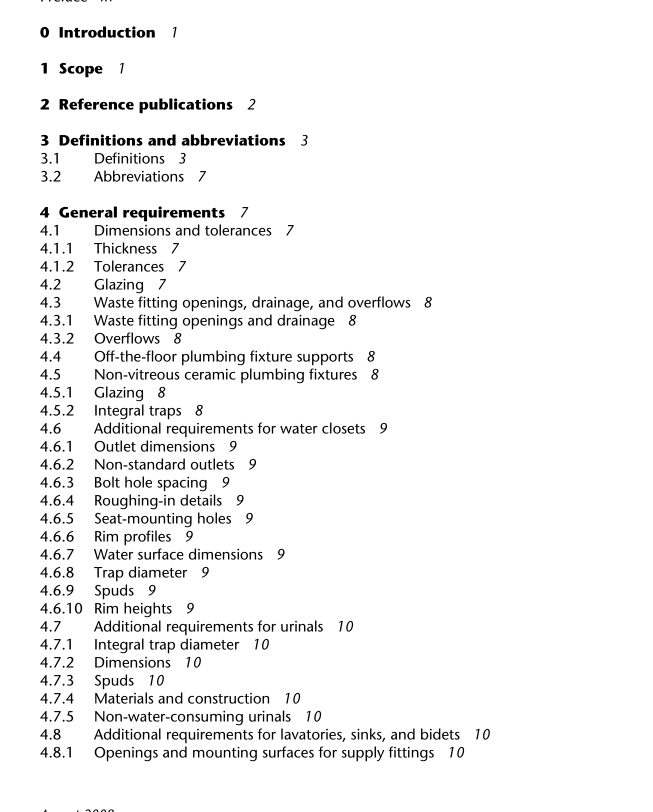ASME A112.19.2:2008 pdf download Ceramic plumbing fixtures
Note: See ASME A112.18.1/CAN/CSA-B125.1 and CAN/CSA-8125.3 for definitions of specific types of ittings.
Fixture — a device that receives water,waste matter, or both and directs these substances into a drainagesystem.
Flood level – the level at which water will overflow a fixture.
Flush cycle — the complete operating sequence of a water closet or urinal in emptying its contents,cleaning its inside surfaces, and refilling the water seal.
Flushing device — a device for delivering water into a water closet bowl or urinal.
Flush tank — a vessel that stores a predetermined quantity of water and includes a flushing deviceto discharge water (plus some through-flow from the water supply line) into a water closet bowl orurinal.
Note: A common type of flush tank is a wall-hung vessel or a vessel close-coupled with the water closet bowl thot isfitted with a fil valve and flush valve.
Flush valve — a valve for discharging water from a flush tank into a water closet bowl or urinal.
Pressurized flushing device — a flushing device that is employed in non-gravity flushing systemsand uses the water supply to create a pressurized discharge to flush fixtures.
Note: Flushometer tanks, flushometer valves, and electronically controlled pressurized devices are examples ofpressurized flushing devices (see CAN/CSA-B125.3 and AsSE 1037).
Flushometer tank — a flushing device that effectively enlarges the water supply pipe
immediately before the water closet bowl or urinal by being integrated within an accumulatorvessel affixed and adjacent to the fixture inlet.
Flushometer valve — a flushing device attached to a pressurized water supply pipe that, whenactuated, opens the pipe for direct flow into the fixture at a rate and in a quantity that enablesproper operation of the fixture.The valve then gradually closes to provide trap reseal in thefixture and avoid water hammer.
Note: The pipe to which the flushometer valve is connected should be large enough to enable delivery of waterat a sufficient rate for proper operation.
Flushing surface — a surface that is visible after installation and is wetted during operation of a watercloset or urinal.
Glaze – a smooth, impermeable, glass-like ceramic coating.
Gravity flush tank water closet — a water closet designed to flush the bowl with water supplied bygravity only.
lntegral- a cast or formed part of a fixture, e.g., a trap, seat, or tank.Lavatory — a washbowl or basin.
Low-profile tank – a tank on a water closet that employs a flushing device that is below the flood levelof the water closet bowl.
Pottery square — a square opening 51 mm (2.0 in) on each side cut into a sheet of flexible material andused to count the number of defects in the opening (see Tables 1 and 2).
Pressure –
Flowing pressure – the pressure in a water supply pipe at the inlet to an open valve.Static pressure – the pressure in a water supply pipe at the inlet of a closed valve.
Rim – the unobstructed open edge of a plumbing fixture.
Sanitary – an aesthetic condition of cleanliness (not the state of being microbiologically clean).
siphonic action — the movement of water through a flushing fixture by creating a siphon to removewaste material.
Siphonic bowl— a water closet bowl that has an integral flushing rim, a trap at the front or rear, and afloor or wall outlet, and operates with a siphonic action (with or without a jet).
Spud — a fitting used to connect a flushing device to a water closet or urinal.
Trap — a fitting, device, or integral portion of a fixture that provides a liquid seal that prevents the backpassage of sewer gas without affecting the flow of wastewater.
Trap dip – the highest internal surface of the lowest part of a trap (see Figure 13).
Trap seal depth — the vertical distance between the weir and the trap dip or, if applicable, between theweir and the trap dip or the top edge of a jet opening, whichever is higher.
Trim – parts made of materials other than china that are normally supplied with a fixture, e.g., spuds,wall hangers, and flush valves (but not including fittings)(see CAN/CSA-B125.3 or ASMEA112.19.5).Urinal — a fixture that receives only liquid body waste and conveys the waste through a trap into adrainage system.
High-efficiency urinal — a urinal with an average water consumption of 1.9 Lpf (0.5 gpf) or lesswhen tested in accordance with this Standard.
Low-consumption urinal— a urinal with an average water consumption of 3.8 Lpf (1.0 gp) orless when tested in accordance with this Standard.
Non-water-consuming urinal — a urinal that conveys liquid body waste through a trap seal into agravity drainage system without the use of water.
Visible surface — a surface of a fixture that is readily visible to an observer in a normal standing positionafter the fixture is installed.
Visible after installation — a surface that remains visible (not necessarily from a normal standingposition) after the fixture is installed.
Warpage — a defect in a fixture resulting in a concave or convex gap between the fixture and theadjacent wall or floor.
Washdown (washout) bowl— a water closet bowl that has an integral flushing rim and a floor or walloutlet and primarily operates with a non-siphonic action.
Water closet — a fixture with a water-containing receptor that receives liquid and solid body waste andon actuation conveys the waste through an exposed integral trap into a drainage system.
ASME A112.19.2:2008 pdf download
